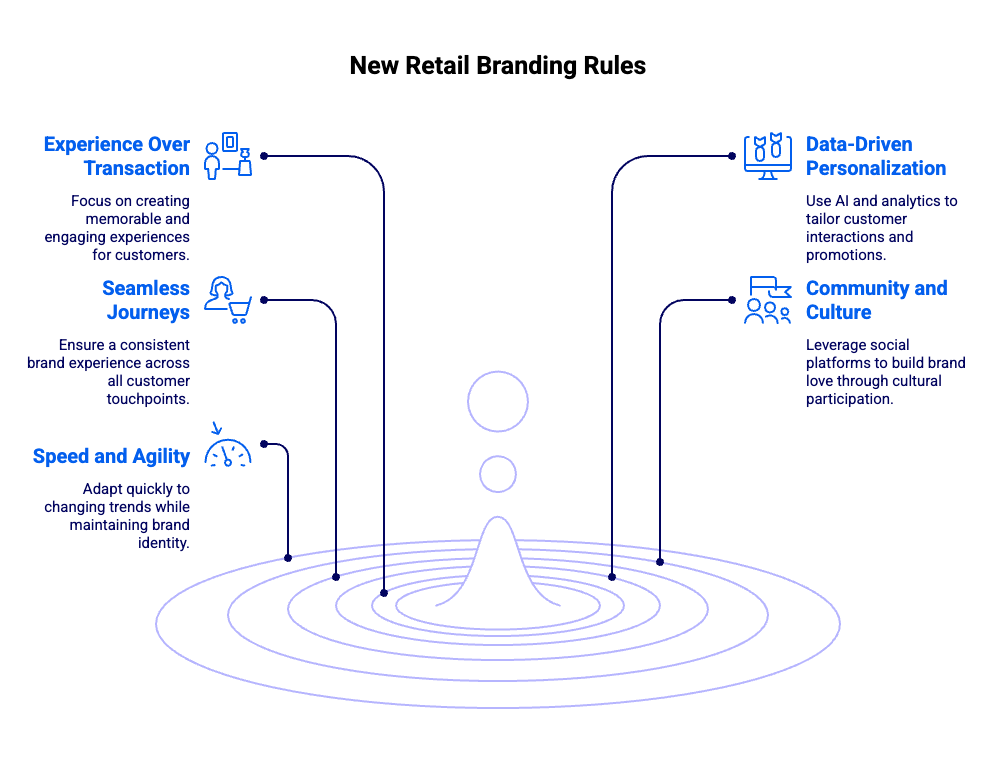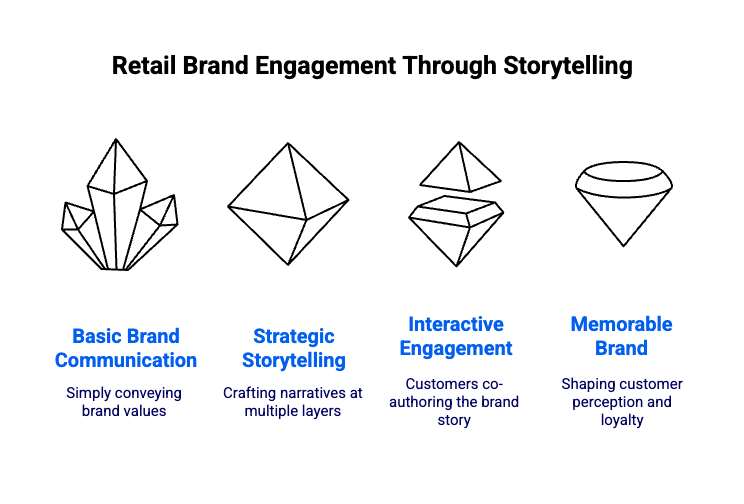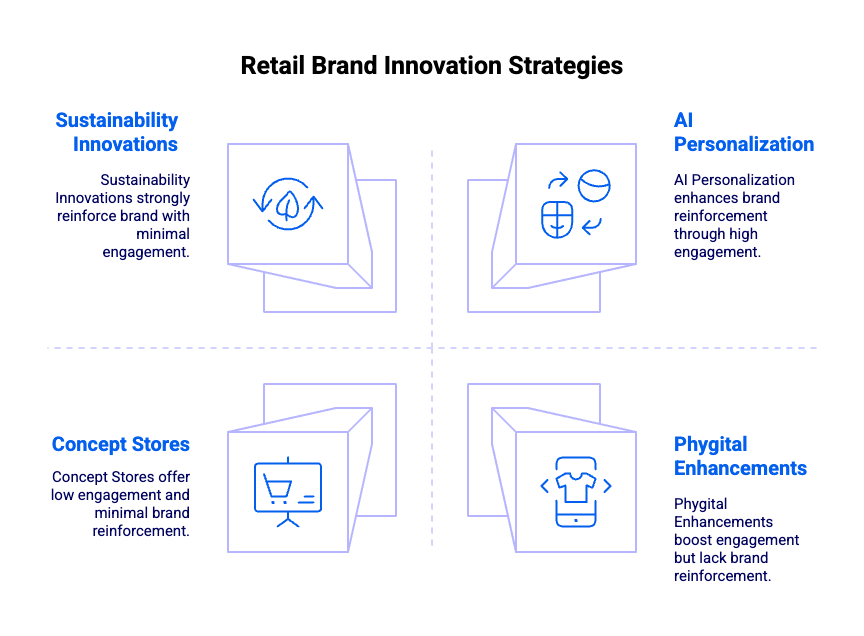Retailers’ physical stores are no longer purely transactional spaces. Consumers increasingly see them as venues for inspiration, discovery, and community places to experience a brand’s world rather than just shop its assortment.
The Rise of Experiential Retail Spaces
Consider Glossier’s flagship in New York. Rather than functioning like a traditional beauty store, it was conceived as a physical embodiment of a digital community. Fans who had discovered the brand through Instagram and peer-to-peer content flocked to the space to take selfies on the iconic pink staircase, talk to like-minded beauty enthusiasts, and participate in the brand’s story. Sales happened almost incidentally a byproduct of immersion rather than a hard sell.
Nike’s House of Innovation in Shanghai and New York pushes this idea even further. The store combines customizable product zones, AR-enhanced storytelling, and spaces for live events. Visitors can design their own sneakers, attend workshops, or just explore interactive installations. It’s less like walking into a store and more like stepping into a branded cultural playground, where inspiration precedes transaction.
Luxury Retail as Cultural Experience
Luxury players have also embraced this mindset. Gentle Monster, the Korean eyewear brand, treats every store like an art gallery immersive installations, conceptual sculptures, and performance art pieces create an experience that blurs the line between retail, culture, and entertainment. The effect? Visitors post the space on social media platforms, talk about it, and return often with friends, because it’s a destination worth experiencing, not just a store to pick up frames.
Community Building Through Retail Spaces
Large chains and national brands are also adapting: Starbucks Reserve Roasteries transform the coffee run into a theatrical ritual: copper casks, overhead conveyor belts, tasting flights, and live roasting demonstrations. The goal isn’t just to sell coffee; it’s to immerse consumers in the craft, atmosphere, and story of Starbucks, deepening brand attachment in the process.
As an outdoor retailer, REI’s flagship stores double as community hubs. They host climbing walls, workshops, trail cleanups, and events where outdoor enthusiasts connect with each other. By fostering a sense of belonging, REI transcends being a place to buy gear it becomes a platform for community and shared values.
The New Retail Paradigm: Experience First, Sales Follow
What these brands share is a fundamental inversion of the retail equation: Instead of “people come to stores to buy things,” the new paradigm is “people come to stores to feel, learn, and connect and as a result, they buy.”
This shift isn’t cosmetic; it’s structural. When retail spaces function as cultural stages, they drive higher dwell times, deeper brand associations, richer storytelling opportunities, and increased organic advocacy. In essence, they turn physical stores into media channels, amplifying the brand far beyond their square footage.
What is Retail Branding and Why It Matters
Retail branding is the systematic creation and management of a retailer’s identity, positioning, and experience across all consumer interactions. It encompasses visual identity, store and digital experience, customer experience, tone of voice, and community engagement.
Consumers expect strong brands to stand for something clear and consistent. This goes beyond excellent customer service it’s about having a distinct “why” that guides everything from assortment to store design. Successful retail branding strategies clearly show consumers brand purpose (a clear reason for being that resonates culturally (e.g., REI’s “Opt Outside,” Patagonia’s environmental activism, Sephora’s beauty inclusivity) and brand positioning (a compelling and differentiated promise that sets the retailer apart (e.g., Trader Joe’s “unique, curated finds at great value,” or Nike’s blend of performance and inspiration).
Successful retail branding strategies are also expected to remove friction and deliver convenience, both online and offline, or in hybrid journeys. Consumers no longer think in “online and offline channels” they think in fluid experiences, involving unified journeys (research online, try in-store, buy via app, return by mail all without losing continuity), consistent identity and customer experience (the look, tone, pricing, and service ethos should be consistent across all touch points), and ease and speed (checkout, delivery, returns, and support should be intuitive and fast).
Think of Nike’s ecosystem of stores, apps, membership, and digital services, which are designed so consumers never feel like they’re “switching” between online shopping and in-store shopping; they constitute one continuous brand world and consistent brand experience.
Successful retail branding creates clarity and differentiation while keeping a consistent brand image. It drives preference in crowded categories, builds emotional loyalty, and creates brand loyalty. In an era where products are easily copied and prices easily compared, brand meaning and experience become the ultimate competitive advantages.
The New Rules of Retail in a Digital-First World
Merely having a strong online or social media presence is not enough in today’s world. Consider five new rules shaping the industry:
- Experience over Transaction
Consumers increasingly see retail spaces as venues for inspiration, discovery, and community, not merely as warehouses for products. Apple’s flagship stores, for example, are designed less as stores and more as “town squares” for cultural engagement. - Data-Driven Personalization
To boost sales, digital-first retailers leverage AI and predictive analytics to tailor everything from recommendations to promotions. Amazon’s algorithmic personalization set the standard, but now even legacy players like Walmart are investing heavily in real-time personalization engines. - Seamless Journeys
Shoppers move fluidly between channels: researching online, buying in-store, returning via app, or vice versa. It is key to maintain a consistent brand experience as well as a consistent brand identity at all of these touchpoints all the way down to product packaging, so the journey feels like one continuous conversation. - Community and Culture
Platforms like TikTok, Instagram, and Twitch have become cultural arenas where retail brands are built or broken. Sephora’s use of creator partnerships and user-generated content demonstrates how cultural participation drives brand love. - Speed and Agility
Retail cycles have shortened dramatically. Trends that once lasted seasons now peak and fade in weeks. Branding strategies need to be modular and adaptive, allowing for rapid campaigns while still maintaining a consistent brand identity.

Retailers that thrive in this landscape view digital transformation as a brand transformation, not just a technological upgrade.
Differentiating Your Retail Brand in Saturated Markets
The retail business is characterized by high competitive intensity and low structural differentiation. Most retailers carry overlapping product assortments; consumers compare prices instantly; physical formats often feel interchangeable. In this environment, brand becomes the most powerful lever for differentiation.
Strategic differentiation involves:
- Owning a Distinct Positioning: Whether it’s Trader Joe’s focus on quirky private labels, REI’s community-driven outdoor ethos, or Sephora’s curated beauty playground, marketing efforts should be focused on defining a unique identity and customer experience.
- Codifying Distinctive Brand Assets: Visuals, language, tone, even store music and lighting can become semiotic signals. Think of Target’s red bullseye or IKEA’s blue-and-yellow warehouse aesthetic.
- Emotional Resonance: Retailers that tap into cultural currents (e.g., Patagonia’s activism, Lululemon’s wellness positioning) engender customer loyalty and transcend price wars or any competitive market.
Differentiation is not about being louder it’s about being more meaningfully distinct, both strategically and emotionally.
Building a Strong Retail Brand Identity
A strong retail identity provides strategic coherence across a complex ecosystem of touch points, and should encompass both core elements (timeless associations) and extended elements (flexible signals that can adapt to trends).
Key elements include:
- Purpose & Promise: Articulating the deeper “why” that guides decision-making. For example, REI’s “Opt Outside” is both a brand promise and a cultural stance.
- Distinctive Design Systems: This helps with maintaining brand consistency. Nike’s retail experience integrates the Swoosh, bold typography, and kinetic layouts consistently whether in a flagship store or mobile app.
- Humanized Tone & Behavior: Employees are often the most powerful brand ambassadors. Ritz-Carlton famously empowers frontline staff to deliver the brand promise through micro-interactions.
Strong retail identities scale globally but express locally allowing for cultural adaptation without strategic drift.
Physical, Digital, and Phygital: Branding Across All Touchpoints
“Phygital” retail the blending of physical and digital is no longer optional. According to McKinsey, 70% of consumers use both digital and physical channels throughout their shopping journey. Successful retain branding strategies must therefore design coherent ecosystems where each touchpoint reinforces the others.
- Physical: Build immersive, sensory experiences that anchor emotional memory. Starbucks Reserve Roasteries, for instance, create theatrical environments that elevate the brand far beyond a standard café.
- Digital: Ensure brand tone, UX design, and storytelling remain consistent. A luxury retailer with a clunky website undermines its own brand image.
- Phygital: AR try-ons, QR-enabled storytelling, and mobile-enhanced in-store navigation are strategic amplifiers, not gimmicks. Nike’s SNKRS app and House of Innovation stores illustrate how digital layers can enhance exclusivity and engagement.
The key is intentional orchestration of multiple platforms, ensuring that the brand narrative unfolds seamlessly across every interface.
The Role of Storytelling in Retail Brand Engagement

Storytelling not just communicates a brand’s brand values, but also helps create a memorable brand shaping customer perception while transforming merchants into cultural narrators. Strategic storytelling operates at multiple layers:
- Corporate Narrative: What the brand stands for (e.g., Patagonia’s environmental ethos).
- Product Narratives: Stories that add value and differentiation to merchandise (e.g., Lush explaining handmade processes).
- Community Stories: Highlighting real customers, local collaborations, or shared missions builds authentic engagement loops.
Importantly, retail storytelling should be interactive, not one-directional. Brands like Glossier built communities where customers became co-authors of the brand story, shaping everything from product development to content creation.
Designing Memorable In-Store Brand Experiences
In-store experiences remain a critical canvas for brand building, and often the most emotionally powerful one. Effective retail experience design is not merely for a superior customer experience. It considers:
- Zoning and Narrative Flow: Apple’s stores lead customers through a deliberate choreography of discovery, engagement, and consultation.
- Multisensory Branding: Abercrombie’s iconic (if polarizing) scent strategy made its stores instantly recognizable.
- Service as Theatre: Associates at Lululemon or Nordstrom are trained to deliver experiences that reinforce brand personality.
- Community Activation: Brands like REI use their stores as community hubs, hosting events and outdoor activities that extend the brand beyond commerce.
The in-store experience is not simply about aesthetics it’s about encoding brand meaning into behavior, space, and ritual.
Creating a Cohesive Omnichannel Retail Brand Strategy
In today’s marketplace, consumers don’t think in channels they think in journeys. They move fluidly between a mobile app, a physical store, a social feed, and a customer service chat, often within the same purchase cycle. Effective retail branding means that brand strategy must extend seamlessly across every touchpoint, not as a series of disconnected tactics, but as a cohesive ecosystem.
The most successful omnichannel retail brands follow five key strategic principles:
- Start with a Unified Brand Narrative, Not Channel Silos: Many omnichannel strategies fail because they treat each channel as a separate marketing or operational domain. A strong retail brand, by contrast, articulates a single, unifying narrative that flows across all interfaces. Develop a core brand story and identity system that acts as a “master script” adaptable for different channels, but never fragmented.
- Design for Seamlessness, Not Just Presence: Being “everywhere” is not the goal; being consistently, intelligently connected everywhere is. Consumers expect to start in one channel and finish in another without friction. Map the entire consumer journey, identifying where channels intersect and how information, identity, and experience can carry over. This requires integrated data systems, single customer IDs, and shared content platforms, not disconnected tech stacks.
- Design Experiences Around Human Behavior, Not Channel Hierarchies: Omnichannel shouldn’t be driven by organizational charts it should be designed around how people naturally move between contexts. For example: Sephora integrates in-store consultations with digital beauty profiles. A skin analysis in store automatically updates your online recommendations, and your app “loves” inform in-store product placements. This provides customers with a feedback loop between exploration and personalized shopping experience.
- Align Internal Structures and Incentives: True omnichannel cohesion isn’t just a design problem it’s an organizational alignment challenge. Many retailers still operate with separate P&Ls, KPIs, and teams for e-commerce vs. brick-and-mortar, leading to conflicting priorities. Create cross-functional teams that own the end-to-end journey, not just their channel. Align incentives around customer lifetime value and brand equity, not isolated sales metrics.
Retail Brand Architecture: Organizing for Growth
As retailers expand, brand architecture becomes crucial to clarity and scalability. There are three dominant models:
- Branded House: One master retail brand across all offerings (e.g., IKEA). Advantages include simplicity and scale, but flexibility can be limited.
- House of Brands: Distinct retail banners under one corporate parent (e.g., Inditex with Zara, Massimo Dutti, Pull&Bear). This allows tailored positioning for different segments.
- Hybrid Models: Parent endorsement plus sub-brands (e.g., Amazon with Whole Foods, or Target with Good & Gather).
Strategic architecture helps avoid brand overlap, cannibalization, or dilution. For example, Target’s clear delineation between its master brand and its owned private labels allows each to reinforce the other while serving different strategic goals.
Retail Brand Innovation: From Concept Stores to AI Personalization

Innovation must always amplify the brand, not overshadow it.
- Concept Stores like Nike’s House of Innovation or Gentle Monster’s immersive spaces function less like retail stores and more like R&D labs for customer experience.
- AI Personalization powers smarter recommendations and adaptive merchandising. Sephora’s integration of AI with human beauty advisors blends scale with intimacy.
- Sustainability Innovations such as refill stations or circular retail concepts (e.g., IKEA’s furniture buyback program) reinforce brand purpose.
- Phygital Enhancements like AR mirrors or interactive product storytelling transform shopping into participatory experiences.
Innovation in retail branding isn’t about chasing shiny objects it’s about aligning technological possibilities with strategic intent.
Measuring Brand Performance in Retail Environments
Robust measurement systems connect brand investment to business impact. Advanced retailers track:
- Brand Equity Metrics: Awareness, preference, distinctiveness, cultural relevance.
- Behavioral Metrics: Footfall, dwell time, conversion rates, engagement.
- Financial Metrics: Margin growth, basket size, lifetime value.
- Omnichannel Metrics: Cross-channel journeys and attribution models.
Some are now integrating AI-driven predictive analytics to connect leading indicators (e.g., social buzz) with lagging outcomes (e.g., sales growth), enabling faster strategic course correction.
Future-Proofing Your Retail Brand for What’s Next
The retail industry faces a volatile, uncertain, complex, and ambiguous future, particularly for the most traditional retailers in an increasingly crowded market. To increase brand visibility, brands should master three imperatives:
- Cultural Intelligence: Rapidly reading and responding to shifting values from sustainability to identity politics without opportunism.
- Technological Fluency: Integrating AI, AR, and emerging interfaces not as bolt-ons, but as core strategic enablers.
- Strategic Agility: Building modular branding systems that evolve without eroding equity, enabling speed without chaos.
Brands like Nike, IKEA, and Sephora show that future readiness isn’t about predicting trends it’s about designing organizations and brand systems that can flex intelligently.
Conclusion: Retail Branding as a Growth Engine
What was once considered “the last mile” of the customer journey has become the first mile of emotional connection, and increasingly, the engine that drives sustainable growth.
When retail branding is treated as a core business lever not just a marketing garnish it creates durable advantages. It drives footfall and click-throughs, yes, but more importantly, it builds cultural relevance, emotional equity, and long-term customer value.
At Vivaldi Group, we help retailers navigate this transformation not by chasing trends, but by designing brand systems that connect cultural insight, digital fluency, and business strategy. It’s how a brand moves from being seen to being experienced, from being purchased to being loved, from existing in markets to shaping them.
